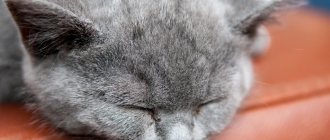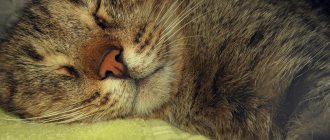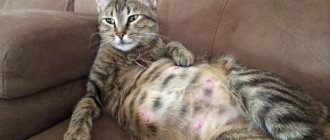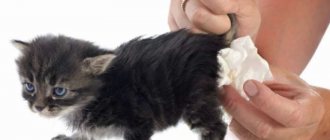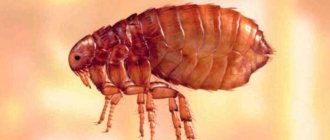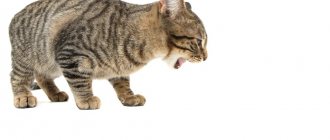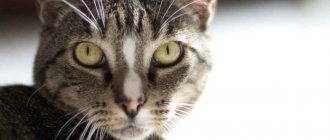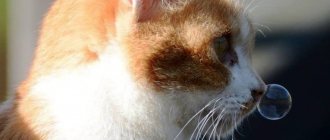Animal feces have diagnostic value for a veterinarian. As a rule, it is sent to the laboratory to check for the presence of parasites, but by asking the owners about the color, consistency of feces and frequency of bowel movements, the veterinarian can make preliminary conclusions about the presence of diseases of the internal organs. How can cat owners understand that the stool is not in order and that they need to take their pet to the veterinary clinic?
What might the stool of a sick animal look like?
In the tray of his pet, the owner may find feces that differ in shape:
- ointment-like;
- mushy;
- liquid;
- foamy;
- in the form of “goat peas”;
- in the form of a tape or pencil.
By smell they distinguish: sour, rancid, putrefactive.
- Feces acquire a sour smell when the absorption of fatty acids in the small intestine is disrupted or due to fermentation processes in the large intestine.
- An unpleasant odor, similar to the smell of bad oil, occurs when the secretory function of the pancreas is disrupted or when the flow of bile is disrupted.
- The smell of rotting occurs when digestion in the stomach is disrupted, dyspepsia develops with the proliferation of putrefactive microflora in the intestines. Or the cat suffers from colitis with ulcerations.
It is customary to distinguish feces by color:
- red (beetroot);
- black (tarry);
- dark brown;
- light brown;
- with a scarlet admixture (undigested blood);
- yellow;
- light yellow;
- greenish yellow;
- bleached slightly yellow, gray, gray-white.
A healthy cat can have red or beetroot feces if it has eaten beets or food colored with bright dyes. This coloring is not pathological and soon the stool acquires a normal color.
Diagnostics
If the owner has noticed that his cat has pooped more than once with feces that are significantly different in color, smell and consistency from the norm, it is necessary to find out the causes of this pathological condition as soon as possible, so a visit to the veterinarian and a comprehensive diagnosis is indispensable. At the first appointment, the doctor will examine the pet, ask the owner what symptoms are bothering his pet and how long the problems with bowel movements have been observed. If it is not possible to immediately establish an accurate diagnosis, a referral is given to such additional research methods as:
- general clinical analysis of blood and urine;
- fecal analysis for the presence of worms, as well as blood, mucous and other inclusions;
- biochemistry;
- Ultrasound of the abdominal organs.
Return to contents
What can be prescribed for a kitten:
- the first day is a fasting day (only water or a very weak chamomile decoction);
- for viral diseases - antiviral serum;
- for bacterial infections - antibiotic therapy;
- if the kitten is poisoned - the drug Atoxil;
- in the presence of worms - antihelminthic drugs;
- probiotics to normalize intestinal microflora;
- antispasmodics for severe pain syndromes;
- to restore the water-salt balance - Regidron.
After the therapy, the babies quickly recover, their digestive system returns to normal and the mucus in the stool disappears. Of course, provided that the owner sounded the alarm in time and consulted a doctor.
Feces with mucus in a cat are almost always a signal of the onset of an illness. Such phenomena cannot be ignored, as this can lead to serious health problems for the pet. And the blame for all the suffering of the pet will lie only with the careless owner, who did not notice the alarming symptoms in time or ignored them.
Causes of changes in stool color
The color of feces, as well as its smell, and consistency change due to errors in the animal’s diet or disturbances in the digestive process, in the movement of the food bolus through the intestines, due to evacuation dysfunction or enzymatic deficiency. For the same reason, a cat's stool may contain large amounts of mucus.
Black-colored feces indicate the presence of blood in the stool that has been enzymatically processed in the stomach. This means that the animal is bleeding from one of the upper parts of the digestive tract (esophagus, stomach). This type of feces is called melena and its appearance is usually accompanied by additional symptoms: a disturbance in the general condition of the animal, weakness, and sometimes vomiting.
Very dark, brown, almost black color of feces occurs in cats due to insufficient digestion of food in the stomach. With the development of pathogenic microflora (putrefactive) in the cat’s intestines, the feces also become very dark. In addition, it acquires an unpleasant specific odor similar to the smell of decaying meat. Stool may be dark if you are constipated. In this case, the consistency becomes dense and looks like a highly structured sausage or individual dense peas. Ulcerative colitis, increased secretory activity of the mucous lining of the large intestine can cause too dark stool.
Light, slightly brown feces occur in animals with increased evacuation function of the large intestine. With the active movement of the food bolus through the intestines, the food is not processed properly. And nutrients are not fully absorbed from it.
An animal's stool may be mixed with fresh blood due to ulcerative colitis, a disintegrating tumor of the lower intestine, or trauma to the lower intestine with a sharp object (a fragment of a chicken bone, a needle or another object swallowed by an animal). A small amount of blood may be present in the stool with anal fissures and bleeding from hemorrhoids. With internal hemorrhoids and spastic colitis, the animal's feces take the form of a ribbon or pencil.
Yellow feces occur in animals on a dairy diet. This color of stool can be due to disruption of digestive processes in the small intestine and the development of dyspepsia associated with fermentation processes. Very light yellow stool occurs when the enzymatic activity of the pancreas is insufficient.
Stool may have greenish impurities due to the presence of bilirubin in it (normally it is absent). Bilirubin enters the stool due to increased peristaltic activity or prolonged use of antibacterial agents and sulfonamides. Suppression of intestinal microflora leads to dysbiosis, although it is believed that cats do not suffer from it. This may be rare in the wild, but eating foods containing antibacterial agents and using such drugs for treatment can lead to serious suppression of the cat's natural intestinal microflora.
Colorless, depigmented or grayish-white feces occur in an animal due to the lack of bile pigments that color it. This occurs when access to the intestines for bile is blocked. A similar situation arises due to infectious diseases of the cat, which cause hepatitis. The reason for the lack of release of bile into the intestines may be mechanical defects (severe spasm of the bile ducts, blockage with a stone), helminthic infestations and organic pathology of the hepatobiliary system (including the growth of tumors). Usually, in this case, the cat’s urine becomes a rich beer color, weakness appears, the quality of the coat deteriorates, and appetite is impaired. Visible mucous membranes, the whites of the eyes and the inside of the cat's ear turn a bright yellow color.
Why does mucus appear in stool?
It is difficult not to see that a cat has mucus in its stool. Usually this phenomenon is immediately noticeable and looks like transparent or whitish impurities in the general stool. Sometimes there are not many of them, but sometimes the feces are completely covered with mucous secretions. In any case, this is an anomaly that may indicate pathologies that have arisen in the animal’s body.
shutterstock
The appearance of mucus in stool can be caused by a number of reasons:
- the presence of worms;
- viral or bacterial diseases;
- intolerance to certain foods;
- excessive overfeeding;
- metabolic failures;
- intestinal obstruction;
- stressful state (when changing place of residence or owners);
- food that is too fatty;
- incorrectly formulated diet or eating disorders;
- inflammatory processes in the digestive system;
- consequences of poisoning with bad food, chemicals or poisons;
- abrupt change of menu;
- allergy;
- decreased body resistance to diseases;
- reaction to certain drugs;
- wool in the stomach.
The reasons are so varied that it is almost impossible for an ignorant person to independently determine why a cat poops feces with mucus. But the fact that not everything is all right with the pet is obvious. In addition to the foreign impurities themselves, additional symptoms help to understand this.
Associated signs of an unhealthy pet
The following symptoms, which can appear due to a number of diseases, should be a reason to worry about your cat:
- diarrhea with mucus may indicate an overdose of vitamins;
- flatulence and diarrhea often indicate food intolerance that has arisen, which will simply need to be excluded from the diet;
- lumps of mucus in liquid feces, nausea, weight loss, sometimes vomiting, and at the same time the cat often licks itself - chronic inflammation in any part of the digestive tract is possible;
- the feces have become greasy, bright yellow or greenish, vomiting, flatulence, nausea have appeared, appetite has noticeably increased - it’s time to check your pet’s pancreas;
- the cat has blood and mucus in its stool, the animal feels sick and vomits, it loses its appetite, the pet experiences a sudden weight loss - this is due to viruses or bacteria;
- the stool is liquid, dark, tarry, with mucus, the pet vomits, weight loss is observed - a clear sign of the presence of worms;
- severe diarrhea with clear or white discharge, vomiting, weakness, lethargy, sometimes discharge from the cat’s nose and eyes is visible or there are ulcerations on the mucous membranes - viral diseases are evident;
- the stool is modified, contains mucus, the pet is worried, does not make contact, and especially does not allow the stomach to be felt due to pain - these are symptoms of colitis, enterocolitis or enteritis;
- the feces have a sharp disgusting smell, there are admixtures of mucus and blood - very severe inflammation or cancer of the digestive organs is possible.
shutterstock
Perhaps the only case when you don’t have to worry about mucus in the feces is in the first time after your cat takes anthelmintic drugs (i.e. after deworming). In the first days after the end of such a treatment and prophylactic course, mucus impurities in the feces are observed very often and do not indicate serious pathologies in the cat’s body. The absence of diseases is confirmed by the good general health of the animal (normal appetite, cheerful mood, etc.). No treatment is required here; everything goes away on its own within a few days.
Treatment by a veterinarian
Cat owners should immediately realize that it is not white feces, as such, that are being treated, but the cause that led to this condition is being eliminated. The speed of restoration of the color of feces will depend on the severity of the condition and the general condition of the cat’s body at the time of contacting the veterinary clinic. Sometimes it is possible to restore the color of stool within a few days, sometimes treatment will take longer. There are rare cases when the condition may be irreversible (liver block, oncology).
A correct diagnosis can be made based on:
- clinical examination;
- blood tests (biochemistry and general);
- urine and feces examinations;
- Ultrasound;
- x-ray;
- biopsy (usually taken from the liver, but performed quite rarely).
Any therapy will be meaningless without normalizing the cat’s diet or transferring the cat to a special diet recommended by the veterinarian, according to its state of health.
What treatment is used (schedules and course durations are developed only by veterinarians with individual dosage selection):
- hepatoprotectors that normalize liver functions and metabolic processes (thiotriazolin, Essentiale, Hepatovet, Hepatoject);
- choleretic drugs (ursosan, allohol, cholenzyme);
- relieving spasms and biliary-hepatic colic (buscopan, baralgin, papaverine, mebeverine).
No-shpa is highly not recommended for cats due to the high risk of developing unwanted side effects;
Kitten treatment
What to do if a kitten's stool contains mucus is a question that faces the owner of the animal. Treatment of a kitten differs from the methods used in relation to adult animals.
shutterstock
Most often it looks like this:
- Prescribing hyperimmune serums that help the body fight infections.
- The use of antibiotics to stop the proliferation of bacteria on damaged tissues of the intestinal mucosa.
- The use of prebiotics that restore microflora.
- Prescription of drugs that kill and remove worms.
- Relieving spasms with No-shpa or Papaverine.
- Removing toxins using special medications.
- Restoring water balance. For this purpose, Regidron saline solution is used.
A kitten that has not lost its appetite needs a diet. If the pet refuses to eat or drink, he is prescribed IVs or injections. Having noticed an improvement in the animal’s well-being, he needs to be given rice water and sweetened water for some time. Thanks to this, irritation of the intestinal walls will stop. Chamomile decoction has the same effect.
A kitten has a small body weight, which makes diarrhea more dangerous for it than for adults. Within a couple of days, his condition may become critical, leading to death. Therefore, you should contact a veterinarian when you notice the first signs of the disease.
Previous Question and Answer The cat poops mucus - causes and treatment Next Question and Answer 3 reasons why kittens are born blind
What does it mean if a cat has white stool? The cat has white stools and lethargy
Naturally, each case should be considered individually, because many factors can simultaneously have a direct impact on a cat’s stool, which are not always easy to establish without special tests.
The first thing you should do if you suddenly notice a cat has white stool is to try to remember what he ate the day before, because there is a whole group of products that can affect the bowel movement of animals in such a somewhat unusual at first glance way. In fact, everything has a fairly simple explanation and white feces in a cat can easily be caused by an insufficient amount of enzymes, as a result of which individual ingredients (mainly proteins of animal origin) are not completely digested or, in general, pass through the pet’s intestines. For example, a situation where a cat has white stools most often occurs after eating too fatty dense cottage cheese, white meat and fish. Some types of chicken by-products, and in particular necks, are especially difficult to digest.
Interesting situations also occur with combined feeding, when a pet’s stool can be fragmented not only in consistency, but also in color (partially whitish, partially dark brown with clearly defined boundaries). So, this can be explained by the fact that on the same day the fluffy purr ate dry granulated food and natural proteins (dairy, meat or fish products, etc.). In principle, there is nothing terrible or pathological in this, and if the owner no longer wants to observe such external manifestations in his ward, it is enough to simply reconsider his daily diet.
Another fairly common reason why a cat may have white feces is an imbalance in the protein-carbohydrate balance in their body. Such changes are often observed when a pet regularly receives improperly balanced food and its menu is dominated by carbohydrates, while the entire emphasis should be placed on proteins (proteins of animal origin).
Meanwhile, we should not forget that a cat by nature is a predator and even the fluffiest and most harmless purr is in dire need of meat, so you should not deprive it of such a simple pleasure, because it really is of enormous importance for the normal development of the pet.
That is why an abundance of grain crops, as well as vegetable soups, are not included in the normal diet for cats, although, of course, some types of cereals should still be present in it. For example, almost all cats are recommended to be given rice regularly, even in small quantities. Also, for those pets who suffer from chronic constipation, a significant increase in the volume of ingredients containing easily digestible fiber of plant origin (vegetable stews and soups) is provided. At the same time, the presence of animal proteins in the daily menu must, if not be maintained at the same level, then be reduced in small quantities, mainly by increasing the consumption of carbohydrate-containing ingredients.
If, as a result of such an updated diet, the owner suddenly notices that the cat has white feces, but he is still alert and active, then it is advisable to again amend the menu, continuing experiments until the animal’s stool is completely normalized. Things will be completely different if, in parallel with a change in the color of the stool, other negative symptoms are observed, be it lack of appetite, apathy or, on the contrary, unjustified aggression and irritability, lethargy, drowsiness, as well as an increase in general body temperature.
In this case, there is no point in being idle, waiting for everything to work out on its own, because it is more likely to say that the problem is not in the diet at all, but in the functioning of the pet’s internal organs. So, it is quite possible that the liver or gall bladder has suffered a serious malfunction, which most often occurs when there is an excessive concentration of bile or its obstruction into the duodenum. In the latter case, you should additionally observe your pet’s urine, because if it has changed color, then the above assumption is indeed justified.
In addition, it is necessary to pay attention not only to the fact that the cat’s feces are white, but also to its various impurities and inclusions. The fact is that if a cat's white stool contains mucus or blood, then the problems can be much more serious, affecting the entire digestive system of the pet as a whole.
So, if you notice white feces in a cat with all the side symptoms described above, you should immediately show it to a specialist who will examine and palpate the liver, and also prescribe an ultrasound of the internal organs and a biochemical blood test.
How to cure diarrhea in a cat.
Cat health problems always cause concern for a responsible and attentive owner. Among the most common problems is loose stool, which can occur in both a kitten and an adult.
Most often, it is caused by poor quality food or even overeating, which causes diarrhea and indigestion in the cat. Daily fasting, herbal infusions, activated carbon and other simple and safe remedies help cope with the problem.
If your cat has been diarrhea for more than one day, and mucus is clearly visible in the loose stool, you should definitely go with your pet to a good, experienced veterinarian.
ATTENTION! This phenomenon may indicate more serious diseases than indigestion. And it is extremely important not to hesitate, not to rely on the animal’s good immunity.
If a cat has loose stools with mucus for a long time, the body quickly becomes dehydrated, problems with the kidneys, liver, and the functioning of the cardiovascular system will begin, and long-term and complex treatment will be required. In addition, loose stools may indicate dangerous diseases.
- Eating disorders
Owners try to feed purebred cats and cats correctly, in a balanced manner, choosing special food or a diet made from natural products. And this approach is competent, it allows you to maintain the beautiful appearance of the animal and its good health. But sometimes there is a desire to give your pet an extra portion or feed something fried or delicious pastries. The digestive system, not ready for such changes, malfunctions, food cannot be digested normally, and as a result diarrhea begins. Loose stools can also be caused by food that seems safe for cats, such as milk or raw river fish.
The causes of diarrhea are varied, but most often veterinarians have to deal with overeating of a pet, which was facilitated by the owner’s desire to pamper the pet. Food is poorly digested, putrefactive processes occur on the mucous membranes of the intestines, which is why the epithelium comes off, from which mucus is obtained.
Diarrhea can also be caused by a sudden change in the brand of food. Both manufacturers of ready-made food and veterinarians recommend gradually introducing a new type of food, stretching the transition process over several days.
ATTENTION! There is always a risk of diarrhea when switching to a lower quality feed. Manufacturers of budget food may not adhere to the necessary rules of technology, and the body of an animal accustomed to good products will certainly notice a change for the worse.
- Budget food
When you want to have a purebred cat, you need to realize that such a pet will require certain financial expenses. He will need ready-made food of at least premium class or always fresh natural food from quality products.
Feeding a kitten or an adult cat with economy-class food is dangerous, it contains practically no meat, and a cat, as a predator, needs this product. Protein is most important for feline nutrition; fiber should be present in the diet in small quantities.
Economy-class food contains cereals, but their coarse particles will greatly irritate the intestines and its lining, increasing peristalsis and causing diarrhea. With flakes of food with a large amount of grain, epithelium comes out, which looks like mucus in loose stool.
When eating natural foods, you should also be careful about the choice of products and monitor their freshness. You can’t keep them in the refrigerator for a long time; even such storage reduces their quality and nutritional value. Foods left in the refrigerator for a long time can develop a fungus that can cause cancer.
- Milk
It is mistakenly believed that milk is the best product for a cat. From the age of 3 months, it is recommended to reduce the amount of milk in a kitten’s diet, and for older individuals, replace it with fermented milk products.
Enzymes that can break down proteins and lactose in whole milk are produced only in kittens, and with age they become less and less in the cat’s body. Only those cats that receive it regularly retain the ability to digest milk, but this is an exception.
For most, such a product becomes difficult to digest, and as a result of ingestion, indigestion and diarrhea begin. In such a situation, you should no longer experiment and try to rebuild your pet’s body; constant diarrhea is not only unpleasant, it is dangerous to the health of the animal.
IMPORTANT! There are fermented milk products and other healthy foods from which the cat will receive all the necessary substances and elements, including calcium.
- Allergy
An allergy to certain food components can manifest itself not only as a rash or anaphylactic shock (as an extreme option). Diarrhea is also possible, which occurs not only with new food, but also with food that has already been given to the pet for a long time. You should monitor the cat to see if diarrhea is frequent and what other symptoms are observed.
- Helminth infection
Helminths can also cause diarrhea with mucus; rarely does a cat manage to avoid infection with them. Worm eggs can be brought into the house with shoes, and both kittens and adults become infected. Even if the owner regularly carries out antihelminthic measures and gives appropriate medications, worms can cause intestinal inflammation even in a short time.
As a result of diarrhea, which is observed more than once, the animal’s body becomes dehydrated and weakened; in this case, competent assistance from a veterinarian will be needed.
- Liver diseases
If diarrhea with mucus is not an isolated phenomenon, it is necessary to show the cat to a specialist who will order an examination, establish a diagnosis and prescribe the necessary medications. One of the serious reasons for regular diarrhea may be problems with liver health.
It is responsible for the production of bile necessary for the breakdown of fats. If the liver function is impaired, the animal may experience diarrhea with mucus, which appears as a result of the action of bile on the intestinal lining. In this case, diarrhea is a sign of a dangerous condition; we are talking about the life of the pet.
Signs of liver problems are not only diarrhea with mucus, but also poor appearance of the skin, fur, and the appearance of an unpleasant odor. Treatment is required immediately and comprehensively.
- First aid
Loose stool with mucus in a pet is always a problem, even if the diarrhea lasts for a short time. It is necessary to help the animal’s body before it goes to the veterinarian and receives qualified and effective care. What should the owner do to alleviate the condition of the cat?
ATTENTION! The most important thing is to stop feeding, since the next digestion of food will be an additional burden on the body. Fasting for at least 12 hours!
The pet needs to be provided with peace, there must be access to the tray without restrictions. If the tray is usually in the toilet and the cat needs to call someone to open the door, then in such a situation it is better to take the tray out into the corridor. If diarrhea has been going on for some time and the cat’s body is dehydrated, you can inject him with Ringer-Locke solution subcutaneously (this drug can be bought at the nearest veterinary pharmacy). If your cat has diarrhea, you need to give water often, but in small portions.
After defecation, wipe the anus area with a soft, damp cloth. Cats, despite their cleanliness, will be additionally nervous because of dirty areas of their body.
You can give your pet a decoction of oak or rice, they have a bonding effect. But not every cat will agree to drink such a liquid; you will need to pour a little directly into the mouth with a spoon or a syringe without a needle.
- Treatment
ATTENTION! In the normal state of the body, mucus should not be visible in the stool. If it is noticeable, this indicates an inflammatory process.
The doctor can decide how to treat the animal after examining, examining the cat, and conducting the necessary tests. What does the veterinarian prescribe before determining treatment? Blood tests, stool tests, ultrasound are performed, and in some cases x-rays are also prescribed.
Diarrhea can also be caused by a foreign object, in which case surgical intervention is necessary.
- If diarrhea is caused by a poor-quality product or a sudden change in food, antidiarrheal drugs (Veracol, Enterofuril) are prescribed. Sometimes antibiotics are also needed (Tylosin, Sinulox). The cat will also take probiotics (Acipol, Laktobifid). Absorbents (Smecta, Enterol.Enterosgel...) If you follow all the specialist’s recommendations, you can quickly achieve recovery for your pet.
- But diarrhea can have serious complications, such as dehydration, intoxication, cardiac dysfunction, and hypovitaminosis. The doctor must also prescribe medications to eliminate these complications.
- To increase the vitality of a cat or kitten, hyperimmune drugs (Imunofan, Polyoxidonium) can be prescribed; they also eliminate viral infections.
If you do not pay attention to the consequences of diarrhea, it can lead to death. You need to react especially quickly when your pet has stool with mucus and blood, which may indicate internal bleeding or cancer.
- Preventive measures
Since loose stools with mucus in cats most often occur due to poor nutrition, overeating, and rapid food changes, it is not difficult to take preventive measures and prevent the possibility of diarrhea.
1. When eating ready-made food, the cat should only eat premium or super-premium products.
2. You need to gradually change the finished food to a new one, adding some to the usual diet.
3. Vaccination must be carried out on schedule, because diarrhea can be caused by various infections. You should also regularly perform treatment against internal and external parasites.
4. Natural products used to feed your pet must be fresh and of high quality. It is not recommended to store them in the refrigerator for a long time.
5. As much as you love your cat, you don’t need to feed him treats, as they can be
dangerous for the stomach and intestines of the animal. Taboos on sweets, smoked, fried, salty foods. It must be remembered that even safe products can cause an allergic reaction in a cat in the form of diarrhea with mucus.
6. It is important to keep the bowls from which your cat eats and drinks clean and to clean the tray regularly.
7. The cat should be inaccessible to medications, household chemicals, cosmetics - anything that can get into his stomach and cause poisoning or indigestion.
8. Continued diarrhea with mucus is a serious reason to go to the vet immediately. If treatment is needed, all doctor's recommendations should be followed.
Human remedies for diarrhea can be dangerous for cats, it is better not to treat it yourself.
Article taken from the site: https://koteiki.net
Symptoms of helminthiasis
Signs of parasites appearing in an animal’s body can be different. Symptoms directly depend on the type of helminths that have entered the cat’s body and the degree of worm damage.
At the initial stage, the disease does not detect itself, but progresses very quickly, as a result of which the cat becomes weaker day by day.
The main signs of worm infection:
- The animal becomes lethargic and gets tired quickly.
- Small white worms appear in the cat's stool.
- The pet's belly becomes dense and severe bloating can be observed.
- The cat loses its appetite and may refuse food.
- The fur loses its shine and begins to fall out.
- Vomit.
- Problems with passing stool. Constipation alternates with intestinal upset.
- A cat can “ride” on its butt.
- The pet becomes nervous and restless.
Digestive problems
If your cat's digestive system is unable to digest or absorb the fats and starches in its food, this can result in particularly smelly feces. The technical terms for these digestive problems are improper digestion and improper absorption.
- Solution : Your veterinarian will need to run tests to determine whether your cat is suffering from poor digestion or malabsorption, and will advise you on how to treat each accordingly.
What affects the change in the color of stool to white or gray - the reasons for its discoloration
An element called stercobilin is responsible for the color of stool; it is the end product of the breakdown of bilirubin. Stercobilin colors stool brown. Therefore, light-colored feces indicate a lack of stercobilin. You can read more about the process of coloring excrement and the color variations it can take in the article about the color of feces.
Now let's find out what may be associated with a lack of coloring pigment.
White feces as a result of gallbladder dysfunction
One of the most common causes of white stool is blockage of the gallbladder ducts. Stercobilin is a bile pigment and, due to the difficulty of its transportation, feces become discolored, becoming white, gray or clay-colored. Other symptoms may indicate problems with bile transport, the most obvious being yellowing of the eyes and skin. Blockage of the bile ducts can occur due to tumors or the formation of stones. Stones, in turn, are very dangerous, since the bile duct connects to the pancreatic duct, which will lead to disruption of its secretions.
IT IS IMPORTANT TO KNOW!
Gallstones form due to poor nutrition or frequent fasting. The gallbladder requires regular contractions, which occur during meals. When the gallbladder contracts, it releases bile into the intestines to break down fats. During fasting, there is no contraction and, accordingly, no release of bile, which leads to the formation of stones!
When the pancreatic ducts are blocked, its juices will begin to corrode its own tissues, which will further contribute to the leakage of pancreatic juice, which in turn will begin to break down the body from the inside and can be fatal. Therefore, white feces is one of the signs of the need for an urgent medical examination.
Light-colored stool as a symptom of liver dysfunction
The liver plays one of the main roles in digestion. It is in it that bile acids are formed, which then accumulate in the gallbladder. This is not the only process occurring in the liver that causes the stool to change color to gray or white. A lot of different processes and metabolisms of various kinds of substances occur in the liver. In particular, the metabolism of bilirubin, during the breakdown of which the coloring pigment stercobilin is formed. Various types of liver dysfunction can also appear as white feces.
Other causes of white stool in adults
White feces can be caused not only by the reasons described above; the microflora of the intestine itself can affect the change in the color of poop. Light-colored feces occur when bile pigments do not interact properly due to changes in intestinal microflora.
The microflora, in turn, may change for the following reasons:
- Use of any medications that contribute to intestinal dysbiosis. This phenomenon most often occurs while taking antibiotics.
- Perhaps you have recently experienced severe stress, which could contribute to changes in the intestines that cause lightening of the stool.
- A sudden change in diet or poor nutrition also leads to intestinal dysfunction. This is a stressful situation for the body. Therefore, this factor can be attributed to the above. Most often, this factor influences the change in color of stool to gray in children when changing their diet.
The above-mentioned reasons for changes in intestinal microflora most often cause white feces.
If your feces have changed color to white, gray or clayey and this is accompanied by other changes in your body, for example, nausea, sudden changes in temperature, pain in the liver, yellowing of the eyes or skin, then most likely the cause of the white feces is a malfunction liver and gall bladder. In such cases, you should not self-medicate. Problems with these organs can lead to serious consequences, including death. And incorrect self-treatment will only negatively affect the situation and instead of providing treatment, you only finish off your organs. Our body is an integral system, everything in it is interconnected. And if some organ fails, perhaps the source of the problem is in a completely different place. To identify the cause, it is necessary to undergo a series of tests and conduct an examination; this cannot be done at home.
Why did mucus appear in my cat's stool?
Mucus in the stool may be present due to helminth infection.
It often happens that taking anthelmintic drugs does not stop the release of mucus in the feces. In such cases, you should not worry too much, since the dead worms continue to be excreted along with mucous feces, and after a while the stool returns to normal.
It is possible to eliminate helminthiasis at home, but the presence of inflammation and infectious pathologies requires a medical examination and full control of treatment. In this case, a full range of diagnostics should be carried out and, if a contagious disease is detected, isolation must be carried out.
Causes of the symptom
It can be said that there is rarely any disease that does not cause diarrhea. Possible reasons for the appearance of mucus in stool:
- intoxication due to poisoning;
- overfeeding;
- individual intolerance;
- violation of feeding regime;
- helminths;
- infection of viral and bacterial nature;
- inflammation of the digestive system;
- failure of exchange processes;
- fatty food;
- intestinal obstruction;
- stress;
- a change of scenery;
- menu change;
- reaction to medications;
- decreased body resistance;
- allergy;
- presence of fur in the stomach.
Mucus may appear due to eating fatty foods.
A pet can be poisoned by spoiled food, poisonous plants or chemicals from household cleaning products.
Lactose intolerance
Due to the consumption of dairy products, a reaction to an intolerant product occurs.
A cat may have a reaction in the form of mucus when drinking milk.
Disturbance of balance
An overdose of vitamins provokes intestinal upset.
An overdose of certain vitamins or minerals provokes intestinal upset and, as a result, diarrhea with mucus.
Inflammation of the digestive system
If there is inflammation of the digestive system or genitourinary system, diarrhea will almost always be mixed with mucus and blood.
In the presence of digestive inflammation, diarrhea will always be mixed with mucus.
For all of the above reasons, it is possible to roughly diagnose the factor of occurrence based on some characteristic signs.
- If intestinal flatulence is observed in the presence of diarrhea, individual intolerance can be assumed. All that remains is to identify the specific product that causes such a symptom.
- Liquid stool with a tarry consistency and color will indicate the occurrence of helminthic infestation. It will be accompanied by vomiting and sudden weight loss.
What to do for prevention?
Liquid or dry feces, which are constantly observed in a pet, in any case, are evidence of some kind of internal progressive disorder. To prevent consequences dangerous to the cat’s health and life, it is important to follow preventive rules. First of all, it is important to monitor the cat’s nutrition and provide it with fresh and clean water. Do not forget to carry out preventive anthelmintic treatment.
If viral infectious diseases develop, do not self-medicate, but take the animal to a veterinarian, who, based on the diagnostic results, will select an effective treatment. In order for the cat’s body to more actively resist various diseases, it is useful to strengthen the pet’s immunity. To do this, it is recommended to give courses of vitamins and various biologically active supplements, which are selected by the veterinarian, taking into account the individual characteristics of the cat.
Causes of light-colored stool in pregnant women and children
Before a child can be born, it must be conceived and then carried to term. So let's start with pregnant women first and then move on to children.
In pregnant women, gray feces can be observed due to the consumption of large amounts of fruits and all kinds of vitamin complexes. A child needs a lot of vitamins. If this is not accompanied by abdominal pain and other types of ailments, then most likely there is no cause for concern. When changing the diet, the color of feces should normalize. But it is better to consult a doctor.
Newborn babies may also experience abnormal stool color. Infants' poop may contain white specks. These inclusions are nothing more than lumps of fat from the mother's breast milk. Also, when fed heavily with formula milk, baby shit can take on a light color. Diet adjustments are necessary to normalize the color of the newborn's stool. But do not lose your vigilance, carefully monitor your child’s behavior and possible changes in mood; perhaps something hurts him. In this case, the cause of light-colored poop is no longer food, but something else. In any case, it is better to play it safe and consult your pediatrician.
So the couple came to take stock. Know that you need to regularly check what you got there when you go to the toilet for the most part. What if there is a message or distress signal there for you? In some cases, changes noticed in time will play a significant role in treatment. Be attentive to all changes in your body; it has its own alphabet to communicate with you, and sometimes its letters are poop.
And remember, a site about poop will always be happy to help you in any life situation. We wish you healthy feces and excellent digestion and appetite!
Relief!
Transparent mucus from the anus of a kitten
Just like people, cats often become victims of various diseases. Therefore, if your cat has anal discharge or any other suspicious symptoms, you should attach great importance to this.
The important thing here is to take action in time and seek the help of specialists. Only a doctor can accurately determine the cause of the discharge, identify the disease and give recommendations for treatment.
Causes of discharge from the anus
Discharge in a cat during diarrhea or constipation is quite normal and quite common. They manifest themselves in different ways, but are fairly easy to identify, so they are not too dangerous. The owner may also notice a small amount of blood clots in them. This symptom disappears completely with complete recovery. Therefore, you should not worry too much about this.
But if the discharge from either the anus in a cat or the vaginal area in a cat is purulent or mucous in nature and has a characteristic odor, we can talk about the presence of an infection.
Often this can be associated with problems with the genital organs of cats. But there are other options that require careful testing, special tests and smears. Here you should seek the help of a specialist as soon as possible so as not to aggravate the situation and alleviate the cat’s suffering.
Often the cause of discharge from the anus is inflammation of the paraanal glands. Previously, many were inclined to think that such problems were directly related to the abundant use of dry food in the diet of pets. However, it turned out that this is a myth.
Often, discharge appears due to the unusual structure of the intestine itself. For example, you may notice frequent attempts by the animal to sit on its hind legs or walk along the floor.
Such manifestations of attempts to get rid of excess secretions should be immediately noticeable to the owner.
Treatment of anal discharge
But many pet owners do not want to resort to the services of veterinary clinics. Of course, if the owner is absolutely confident in his abilities and is fully aware of the situation that is happening to his cat, more independent treatment is allowed. However, beginners should listen to the opinion of doctors so as not to put their cat at risk.
Sometimes it is not so easy to rid a cat of discharge from the anus. If the abundance of secretion does not decrease and lasts for several days, an examination should be performed.
Here you must thoroughly wash and disinfect your hands. Next, you need to squeeze the area adjacent to the animal’s sphincter with two fingers.
To avoid worsening the situation, a whole range of measures should be taken to help correct the cat’s condition. Initially, you should arm yourself with special medical gloves. After smearing your finger with Vaseline, you need to insert it into the source of the cat’s discharge.
Carrying out manipulations according to the instructions will lead to an improvement in the pet’s condition within 2-3 days.
However, this procedure cannot be performed without special skills and a full understanding of what is happening. The best thing is to trust the professionals at the veterinary clinic, who will professionally take care of the animal’s health.
If your cat is bleeding from the anus, this may be a reason for surgery. However, this is an extreme measure that is carried out quite rarely.
Often less radical methods of treatment are sufficient, even if it involves bleeding.
After the cat’s condition improves, you should consult a doctor about preventing discharge. This will avoid relapses and improve the cat’s overall condition. Only compliance with the doctor's instructions can prevent the worsening of chronic diseases and the recurrence of inflammatory processes. He can give advice related to:
- cat care; food; routine examinations of the animal.
It's a shame when your beloved pet gets sick. Especially when the kitten has discharge from his butt. However, the main goal, in this case, should be a directed and productive fight against the disease.
Timely measures can not only alleviate the cat’s condition, but also quickly save it from a dangerous disease.
Therefore, most owners try to make every effort to create favorable conditions for their beloved animal to recover.
What do worm eggs look like?
Let's say you find something that looks like worms in your pet's stool, what should you do next? First, you need to understand what you see. Fecal matter may contain live and dead parasites, their eggs, incompletely digested food, and inedible objects that the cat swallowed accidentally or intentionally.
The range of parasites that a cat can become infected with amounts to hundreds of species. Each parasite belongs to a specific family, subfamily or species. Each type of worm has similar features: color, length, body shape, shape and color of eggs. First, let's figure out what worm eggs look like, which you can distinguish visually.
White round spots in stool - what is it?
Almost all worms that parasitize the body of cats are very modest in size and have microscopic eggs that are invisible to the human eye. The exception is tapeworms, which are also called tapeworms and tapeworms.
The body of these parasites consists of:
- Heads with oral apparatus, several rows of hooks and/or suckers.
- Segments (segments) that form a long body.
- This is incredible! Depending on the type of worm, its body can consist of 4–200 segments. Each segment is a vessel for 1–800 eggs, which must be released into the external environment.
The most common tapeworm that affects cats is the cucumber tapeworm (often called borage). Parasite eggs can be identified by visual signs:
- Round with slightly pointed tips, similar to sesame or cucumber seeds.
- White, slightly transparent.
- The main distinguishing feature is that the eggs move and move due to the flat muscles of the segment.
Tapeworm eggs are most often found:
- In feces.
- On the pet's bedding.
- On the fur around the anus.
The life cycle of borage has its own peculiarities. Each worm is hermaphrodite, meaning it reproduces and fertilizes its own eggs. The egg, released into the external environment, begins to move to find a temporary carrier. The egg is eaten by a flea (flea eater), which becomes a vessel for the maturation of the egg.
When the parasite is ready to molt, it hibernates and waits for the right conditions. A flea living on a cat gets caught in the pet's teeth when it tries to relieve the itching. The swallowed flea is digested, and the egg sheds as soon as it enters the intestines.
Once in a suitable habitat, the head of the parasite is implanted into the intestinal mucosa, in other words, it digs into it with hooks and begins to drink blood. Within 30–40 days, the worm matures and becomes sexually mature. Afterwards, the helminth begins to form segments, each of which contains a fertilized egg. The last segment (the tail of the worm) breaks off and comes out with the feces as soon as the egg is ready to “move” into the body of a temporary carrier.
What to do if the stool is white?
Therapy is prescribed by a veterinarian, depending on the etiology of the disease; self-medication is prohibited. If a large stone is observed in cholelithiasis, surgery or crushing and removal of the crystals with a laser is performed. When a tumor is diagnosed, surgery should be performed. For hepatitis, hepatoprotectors and antispasmodics are prescribed. You can expel the cat parasite with anthelmintic drugs. If there are a lot of worms, surgical removal is required. Diuretics and choleretic drugs are also used. A diet is prescribed in the form of lean broth, oatmeal with water and vitamin and mineral complexes. Among the feeds, it is recommended to choose holistic or premium brands with the Sensitive mark.
Your cat is constipated or changes in stool color
14054 views
Lack of bowel movements is always a sign that your pet is unhealthy. The norm is considered to be at least one bowel movement per day.
If the act of defecation occurs untimely and with long delays, this can lead to intoxication of the animal and other serious negative consequences. If you notice that the cat does not go to the toilet or meows and makes other sounds when defecating, spends a lot of time on this process, but often without results, if the feces are dry and the amount is small, you can talk about constipation in the cat. Constipation can be caused by an unbalanced diet, low protein food, dehydration, or the formation of hairballs in the esophagus. In cases of constipation and complicated bowel movements of your pet, you must contact your veterinarian and take the prescribed treatment.
A change in the color of stool may indicate problems of various origins. The normal color of feces is brown. When the color is normal, but the stool is loose, this can be caused by eating poor quality, stale food, as well as infection by parasites. But what if the stool is an unusual color?
If the stool turns black, this may indicate the presence of digested blood, which indicates internal bleeding in the upper digestive tract.
If blood is found in the stool in the state in which everyone is accustomed to seeing it, scarlet or bright red, it means that the blood has not been digested and bleeding is taking place in the lower parts of the digestive tract. In any case, the presence of bleeding in any part of the digestive tract should not be ignored and prompt assistance from a veterinarian.
If your pet's stool has acquired a greenish or yellowish tint, this may indicate problems with digestion of food, dysbiosis and other digestive disorders. If the stool is completely light yellow or even beige, white, this is an indication of a malfunction of the liver.
Grayish feces indicate problems with digesting the food you eat. If the feces are oily or watery, this may indicate failures in the absorption of excess fluid by the intestinal walls.
If any of the listed manifestations of changes in the quality, quantity, or consistency of your cat’s stool occur, you should immediately contact your veterinarian, take stool tests, and, having received the results and referrals from a specialist, begin treatment.
It is strictly not recommended to start treatment with human drugs and dosages on your own, as this can aggravate the animal’s condition and precious time will be lost.
Useful materials:
- Cutaneous horn General description of the disease Cutaneous horn on the forehead or face (ICD 10 code - L57.0) -...
- Cloudy eye in a cat Common causes of cloudy eyes in a cat The most common causes of cloudy eyes are glaucoma, cataracts or keratitis.…
- Itching and odorless discharge Main causesBefore considering the factors that provoke the appearance of discharge that has a sour odor, it is necessary to immediately note...
- Normal temperature in animals Normal temperature in different types of animals Veterinary services Day hospital for animals Veterinary certificates Vaccination…
Causes of blood in stool
Normally, your pet’s stool should not contain foreign impurities in the form of blood, mucus, or undigested food particles. Therefore, if a cat has blood in its stool, this indicates that the pet’s health is not in order. There are many reasons for the development of pathology:
Eating exclusively dry food. Coarse particles injure the intestinal mucosa and irritate it. If at the same time the animal drinks little liquid, then this type of concentrated feeding can cause the appearance of extravasation in the feces.
Chronic constipation. Failure to follow a diet, a small amount of water consumed, and eating “from the table” are common causes of chronic constipation. Hard stool damages the large intestine, which is accompanied by bleeding. Most often, droplets of blood appear at the end of a bowel movement.
Foreign body. Ingestion of sharp objects can cause injury to the mucous membrane of the large intestine. The situation is dangerous for the health and life of the pet and requires immediate contact with a veterinarian.
Helminths and protozoa. A common reason why a cat has blood in its stool is parasites. Many helminths have special adaptations to strengthen themselves in the intestinal walls, which cause injury and damage to the mucous membrane. The symptom can also appear when the animal’s body is infected with protozoa, for example, Giardia, coccidia. Microorganisms lead to increased capillary permeability, which is accompanied by the release of blood in feces.
Bacterial and viral infections. The cause of the appearance of blood in a pet's feces can be infectious diseases (rotovirus, parvovirus enteritis, panleukopenia, etc.). In addition to diarrhea mixed with blood, these diseases are accompanied by fever, vomiting, and dehydration.
Diseases of the pancreas, liver, stomach ulcer. Inflammation of the pancreas in the acute phase, liver dystrophy, in addition to specific manifestations of the pathology, may be accompanied by the presence of extravasation in the feces. With a stomach ulcer, there may be more than just occult blood in the stool. Droplets of blood are also found in the stool.
The reason why a cat passes feces with blood is often chronic colitis. The pathology is accompanied by ulceration of the intestinal mucosa. Owners often note the presence of mucus in their pet’s feces.
Polyps. Benign formations in the form of proliferation of the mucous membrane of the large intestine are quite common in cats. Feces, passing through the large intestine, cause damage and injury, which is accompanied by bleeding.
Malignant neoplasms. Rectal cancer is uncommon in cats, but this serious and life-threatening intestinal pathology should be ruled out. The disease develops gradually and is accompanied by intoxication of the body and metastases to other organs.
Blood clotting disorders. A lack of vitamin K and a violation of the coagulation system lead to the chronic appearance of blood in the pet’s stool.
Poisoning with rodent poisons. Many poisonous substances contain anticoagulants that can cause bleeding in the cat's rectum. Poisoning can occur both through direct contact with poison and when hunting rodents.
The reason why your pet has stool mixed with blood may also be an allergic reaction. This is due to impaired permeability of blood vessels, hemorrhages in the intestinal mucosa.
Often, symptoms accompanied by the appearance of extravasate in feces are caused by ingested fur by animals. This phenomenon is especially often observed in long-haired beauties. Hard hairs injure the delicate mucous membrane, causing microbleeding in the rectum.
Feeding a cat with tubular bones often leads to perforation of the walls of the digestive system, which is accompanied by bleeding and the appearance of extarvasate in the feces.
Dysbacteriosis. Taking antibiotics and unbalanced feeding are often accompanied not only by dysfunction of the gastrointestinal tract in the form of diarrhea, constipation, bloating, but also by the appearance of blood in the stool.
The variety of reasons (from allergies to malignant tumors) that cause bloody stools makes it difficult to diagnose the underlying disease. Therefore, the owner must pay close attention to the symptoms and under no circumstances ignore signs of obvious pathology in the animal.
About your pets' excrement
In this article we will talk about a sensitive topic. about your pets' excrement, aka feces.
Any encyclopedia will tell you - feces (faeces; synonyms: feces, excrement) - the contents of the distal part of the large intestine, released during defecation.
Normally, cats have bowel movements once or twice a day, the stool is formed, slightly moist and soft, dark brown in color, there is no mucus, blood or undigested food in it. Ideally, the size of the stool should be significantly smaller than the amount of food on the plate (25%). When there is less output than input, the cat extracts more nutrients from the food. Large stools are caused by the presence of undigested filler in feed such as corn and other plant products.
The cat walks outside the litter box
Even if your cat's poop doesn't smell any worse than usual, if you don't cover it with a litter box, it will start to smell bad. This could be a sign that the litter is hurting your cat's paws or that she doesn't like the texture or smell of the litter. Cats that poop outside the litter box may have trouble accessing a litter box that has high sides or may have a litter box that is too small.
- Solution : Try switching to a different brand of litter, or offering your cat a lower-sided or much larger litter box. Ask your veterinarian to check if your cat is sick. Cats who are stressed due to a recent change in circumstances may also poop outside the litter box.
